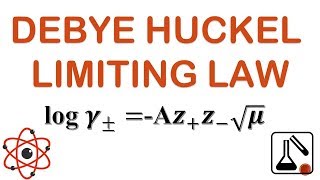Debye-Huckel Limiting Law – Chemistry Notes – For W.B.C.S. Examination.
দেবি-হাক্কেল সীমাবদ্ধ আইন – রসায়ন নোট – WBCS পরীক্ষা।
Coulombic interactions between ions in solution are relatively strong, long-range forces compared to the other types of intermolecular force in solution. They are thus an important contributor to the non-ideality of ionic solutions, and in the Debye-Hückel theory of such solutions, they are taken to dominate the non-ideality to such an extent that all other contributions may be neglected.Continue Reading Debye-Huckel Limiting Law – Chemistry Notes – For W.B.C.S. Examination.
The theory is based around the simple fact that oppositely charged ions attract one another, whilst like-charged ions repel each other.
As a result, the motion of ions in solution is not entirely random; there is a slight tendency for ions of opposite charge to encounter each other more frequently than ions of the same charge.A time-averaged picture of the solution shows that near any given ion, there is an excess of counter-ions.
This time-averaged spherical distribution (in which ions of the same charge as the central ion and counter-ions are both present, though counter-ions predominate) has a net charge equal in magnitude but opposite in sign to the central ion, and is known as its ionic atmosphere. There is a stabilising Coulombic interaction between the central ion and its ionic atmosphere, which has the effect of lowering the energy (and thus the chemical potential) of the central ion.
This model leads to the Debye-Hückel Limiting Law, which applies only at very low concentrations of solute (before other contributions to the non-ideality become important). This law enables calculation of the mean activity coefficient from basic properties of the solution:
where z+ and z– are the charge number of respectively the cation and the anion concerned. A is an empirical parameter, dependant upon the solvent and temperature (eg, for a solution in water at 298K, A = 0.509). I is the ionic strength of the solution, defined as
This means for each type of ion ,i, present in solution, take the charge number of the ion (positive for cations, negative for anions), square it, multiply by the molality of the species, and divide by bº (which has the numerical value 1 mol kg-1 ). Sum the values for each ion and divide by two to obtain the ionic strength.
Note in the above expression the charge numbers appear as their squares, emphasizing the charge on the ions (and hence the Coulombic interaction between them) as a contributor to non-ideality.
The name ‘limiting law’ is applied because in the limit of arbitrarily low molalities (ie as the concentration of the solute gets closer and closer to zero), all solutions are expected to behave in a manner consistent with the expression.
However, at more moderate molalities activity coefficients may differ from the values this law predicts. Experimentally, it is found that agreement is good up to a molality of approximately 0.001mol kg-1 . At higher solute concentrations, large deviations from the predictions of the model are observed.
For Guidance of WBCS (Exe.) Etc. Preliminary , Main Exam and Interview, Study Mat, Mock Test, Guided by WBCS Gr A Officers , Online and Classroom, Call 9674493673, or mail us at – mailus@wbcsmadeeasy.in
Visit our you tube channel WBCSMadeEasy™ You tube Channel
Please subscribe here to get all future updates on this post/page/category/website



 +919674493673
+919674493673  mailus@wbcsmadeeasy.in
mailus@wbcsmadeeasy.in






































































































